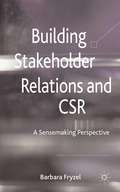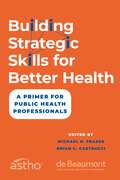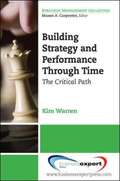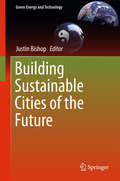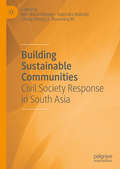- Table View
- List View
Building Societies in the 1980's
by Leigh DrakeBuilding societies are at the forefront of the enormous changes and challenges taking place in industry. This book charts these changes and attempts to explain why they have taken place, and what the significant issues are, for the future development of the industry.
Building Societies in the Financial Services Industry
by Andrew Gall Barbara CasuThis book presents an analysis of the role of UK building societies, their strengths and weaknesses, and their contribution to the industry, at a time where public confidence in banking is low. Chapters present the results of an empirical analysis of the comparative performance of UK building societies, since the large-scale demutualisation process ended in the year 2000. The authors highlight the substantial impact of the financial crisis on the sector, with 2008 and 2009 being particularly difficult years. The book discusses banks and building societies in the context of the improving economy and show that both groups have recovered some profitability, although not at the pre-crisis level. The reader will discover that building societies in particular have recovered well from the financial turmoil and they appear less risky than banks on a variety of measures.
Building Software: A Practitioner's Guide
by Nikhilesh Krishnamurthy Amitabh SaranProviding a framework to guide software professionals through the many aspects of development, Building Software: A Practitioner's Guide shows how to master systems development and manage many of the soft and technical skills that are crucial to the successful delivery of systems and software. It encourages tapping into a wealth of cross-domain and legacy solutions to overcome common problems, such as confusion about requirements and issues of quality, schedule, communication, and people management. The book offers insight into the inner workings of software reliability along with sound advice on ensuring that it meets customer and organizational needs.
Building Software: A Practitioner's Guide
by Nikhilesh Krishnamurthy Amitabh SaranProviding a framework to guide software professionals through the many aspects of development, Building Software: A Practitioner's Guide shows how to master systems development and manage many of the soft and technical skills that are crucial to the successful delivery of systems and software. It encourages tapping into a wealth of cross-domain and legacy solutions to overcome common problems, such as confusion about requirements and issues of quality, schedule, communication, and people management. The book offers insight into the inner workings of software reliability along with sound advice on ensuring that it meets customer and organizational needs.
Building Sponsors (PDF)
by ApmA guide to project sponsorship Background Project sponsorship offers organisations huge opportunities when implemented successfully. While significant work has been undertaken to improve project performance via project delivery teams, little has focused on critical issues of sponsorship and leadership. This may be attributed to the sponsor’s role being hard to define and lacking traction in the boardroom. In 2015, APM ran an extensive research project investigating the Conditions for Project Success. The 12 conditions provide a conceptual framework against which real project delivery could be assessed. The research concluded that while the conditions were widely accepted as being integral to successful project delivery, they were infrequently applied and almost never in full. In five of those conditions, the project sponsor has the lead role. Sponsors’ Summit APM has committed itself to addressing this critical enabler of project success. In January 2018, APM held a Sponsors’ Summit with it's Corporate Partners, government bodies and key stakeholders to start the process of building a shared understanding of how to improve the sponsorship of projects, programmes and portfolios. The summit focused on real-world experiences from the wide range of sectors represented, and was undertaken under terms of full confidentiality. Building sponsors – future project leadership This report lays out key themes that drew a broad consensus. We encourage all those interested in how sponsorship might impact their work and business to use this document to help inform debate within their organisations and networks.
Building Stakeholder Relations and Corporate Social Responsibility
by B. FryzelExplores how companies engage in CSR activities, how their corporate identity determines the way in which they perceive the stakeholders and, as a result, engage in dialogue-based relations with them.
Building Stalinism: The Moscow Canal and the Creation of Soviet Space
by Cynthia A. RuderToday the 80-mile-long Moscow Canal is a source of leisure for Muscovites, a conduit for tourists and provides the city with more than 60% of its potable water. Yet the past looms heavy over these quotidian activities: the canal was built by Gulag inmates at the height of Stalinism and thousands died in the process.In this wide-ranging book, Cynthia Ruder argues that the construction of the canal physically manifests Stalinist ideology and that the vertical, horizontal, underwater, ideological, artistic and metaphorical spaces created by it resonate with the desire of the state to dominate all space within and outside the Soviet Union. Ruder draws on theoretical constructs from cultural geography and spatial studies to interpret and contextualise a variety of structural and cultural products dedicated to, and in praise of, this signature Stalinist construction project. Approached through an extensive range of archival sources, personal interviews and contemporary documentary materials these include a diverse body of artefacts - from waterways, structures, paintings, sculptures, literary and documentary works, and the Gulag itself. Building Stalinism concludes by analysing current efforts to reclaim the legacy of the canal as a memorial space that ensures that those who suffered and died building it are remembered. This is essential reading for all scholars working on the all-pervasive nature of Stalinism and its complex afterlife in Russia today.
Building State Capability: Evidence, Analysis, Action
by Matt Andrews Lant Pritchett Michael WoolcockThis is an open access title available under the terms of a CC BY-NC-ND 4.0 licence. It is free to read at Oxford Scholarship Online and offered as a free PDF download from OUP and selected open access locations. Governments play a major role in the development process, and constantly introduce reforms and policies to achieve developmental objectives. Many of these interventions have limited impact, however; schools get built but children don't learn, IT systems are introduced but not used, plans are written but not implemented. These achievement deficiencies reveal gaps in capabilities, and weaknesses in the process of building state capability. This book addresses these weaknesses and gaps. It starts by providing evidence of the capability shortfalls that currently exist in many countries, showing that many governments lack basic capacities even after decades of reforms and capacity building efforts. The book then analyses this evidence, identifying capability traps that hold many governments back - particularly related to isomorphic mimicry (where governments copy best practice solutions from other countries that make them look more capable even if they are not more capable) and premature load bearing (where governments adopt new mechanisms that they cannot actually make work, given weak extant capacities). The book then describes a process that governments can use to escape these capability traps. Called PDIA (problem driven iterative adaptation), this process empowers people working in governments to find and fit solutions to the problems they face. The discussion about this process is structured in a practical manner so that readers can actually apply tools and ideas to the capability challenges they face in their own contexts. These applications will help readers devise policies and reforms that have more impact than those of the past.
Building State Capability: Evidence, Analysis, Action
by Lant Pritchett Matt Andrews Michael WoolcockThis is an open access title available under the terms of a CC BY-NC-ND 4.0 licence. It is free to read at Oxford Scholarship Online and offered as a free PDF download from OUP and selected open access locations. Governments play a major role in the development process, and constantly introduce reforms and policies to achieve developmental objectives. Many of these interventions have limited impact, however; schools get built but children don't learn, IT systems are introduced but not used, plans are written but not implemented. These achievement deficiencies reveal gaps in capabilities, and weaknesses in the process of building state capability. This book addresses these weaknesses and gaps. It starts by providing evidence of the capability shortfalls that currently exist in many countries, showing that many governments lack basic capacities even after decades of reforms and capacity building efforts. The book then analyses this evidence, identifying capability traps that hold many governments back - particularly related to isomorphic mimicry (where governments copy best practice solutions from other countries that make them look more capable even if they are not more capable) and premature load bearing (where governments adopt new mechanisms that they cannot actually make work, given weak extant capacities). The book then describes a process that governments can use to escape these capability traps. Called PDIA (problem driven iterative adaptation), this process empowers people working in governments to find and fit solutions to the problems they face. The discussion about this process is structured in a practical manner so that readers can actually apply tools and ideas to the capability challenges they face in their own contexts. These applications will help readers devise policies and reforms that have more impact than those of the past.
Building States and Markets: Enterprise Development in Central Asia
by G. ÖzcanThe transition economies of Central Asia are faced with the most daunting challenge of modern capitalism: the move from vassal pseudo-states of the former Soviet Union to competitive nations. This book is the first to explore the first 15 years of economic emergence, and assess the capabilities of these countries to transform their economies.
Building Strategic Skills for Better Health: A Primer for Public Health Professionals
by Michael R. Fraser and Brian C. CastrucciWhile academic programs prepare public health graduates for the technical challenges of practice, many professionals new to the field also need training in the cross-cutting strategic skills required for successful leadership and management of health agencies. Successful practitioners blend subject matter expertise with administrative and leadership acumen to ensure that improvements in public health reach the communities they serve. Building Strategic Skills for Better Health: A Primer for Public Health Professionals offers a dynamic guide for implementing and developing leadership, management, and advocacy skills to transform public health work across disease-focused services toward integrated population health initiatives. Authored by key leaders in public health, this professional primer defines the nine essential strategic skills for effective public health practice across public health specialties: · Systems and Strategic Thinking · Change Management · Justice, Equity, Diversity, and Inclusion · Effective Communication · Resource Management · Data-Based Decision-Making · Policy Engagement · Community Engagement · Cross-Sectoral Partnerships Building Strategic Skills for Better Health equips professionals at all levels with the workforce-readiness tools and knowledge needed to thrive in today's public health agencies.
Building Strategic Skills for Better Health: A Primer for Public Health Professionals
While academic programs prepare public health graduates for the technical challenges of practice, many professionals new to the field also need training in the cross-cutting strategic skills required for successful leadership and management of health agencies. Successful practitioners blend subject matter expertise with administrative and leadership acumen to ensure that improvements in public health reach the communities they serve. Building Strategic Skills for Better Health: A Primer for Public Health Professionals offers a dynamic guide for implementing and developing leadership, management, and advocacy skills to transform public health work across disease-focused services toward integrated population health initiatives. Authored by key leaders in public health, this professional primer defines the nine essential strategic skills for effective public health practice across public health specialties: ? Systems and Strategic Thinking ? Change Management ? Justice, Equity, Diversity, and Inclusion ? Effective Communication ? Resource Management ? Data-Based Decision-Making ? Policy Engagement ? Community Engagement ? Cross-Sectoral Partnerships Building Strategic Skills for Better Health equips professionals at all levels with the workforce-readiness tools and knowledge needed to thrive in today's public health agencies.
Building Strategy and Performance
by Kim WarrenThe fundamental challenge facing business leaders is to drive performance into the future--the dynamics of strategy. To tackle this effectively, they need a clear understanding of what causes performance to improve or deteriorate and what power they have to change this trajectory for the better. Without this understanding, they risk making poor choices about their future--failing to exploit promising opportunities, pursuing unachievable aims, or falling victim to competitive and other threats. Building Strategy and Performance Through Time sets the agenda for building business strategy in powerful, actionable, and accessible terms. It gives executives clear frameworks for answering three fundamental questions: * Why is our business performance following its current path? * Where is it going if we carry on as we are? * How can we design a robust strategy to transform this future? The existing strategy tools most widely used help guide management's choices about where to compete--which customers to serve, with what products and services, and how to deliver those products and services to those customers effectively and profitably. While this choice is important, it is not often changed in any fundamental way; having found a reasonably strong and profitable position on these issues, few firms will, or should, set off in a new direction. But there is still much to be done to deliver that strategy, powerfully and sustainably over time. Many decisions need to be made, continually and holistically, across all functions of the business and adapted as conditions change from month to month and year to year. Pricing, product development, marketing, hiring, service levels, and other decisions cannot be made in isolation but must take into account other choices being made, elsewhere and at different times. Building Strategy and Performance Through Time explains a reliable, practical method, known as strategy dynamics, that creates a living picture of how an enterprise actually works and delivers performance. This picture shows exactly where the levers are that management controls and how to choose what to do, when, and how much, to accomplish your specific goals. It shows, too, how the same approach can be used to defeat competitors, cope with other outside forces, and keep delivering performance.
Building Strong Nonprofits: New Strategies for Growth and Sustainability
by John Olberding Lisa Barnwell WilliamsA proven, strategic plan to help your nonprofit emerge from the 2008-2009 economic storm Utilizing the extensive expertise of leading fundraising consulting firm Skystone Ryan's executive leadership team and managing consultants to explore and illuminate the most timely issues facing the philanthropic community, Building Strong Nonprofits: New Strategies for Growth and Sustainability identifies new opportunities to define the future of philanthropy. Includes notable contributors from the Skystone Ryan leadership team Analyzes the most potent trends and developments and interpret their implications for the future of philanthropy Offers eight to twelve essays, each by a different Skystone Ryan consultant with particular experience, insight, and expertise in the area Building Strong Nonprofits: New Strategies for Growth and Sustainability is you, whether you are a nonprofit leader, executive director, board member, or development director, and are becoming aware that new organizational strategies are called for if the same old donors are not supportive in the same old ways.
Building Strong Nonprofits: New Strategies for Growth and Sustainability
by John Olberding Lisa Barnwell WilliamsA proven, strategic plan to help your nonprofit emerge from the 2008-2009 economic storm Utilizing the extensive expertise of leading fundraising consulting firm Skystone Ryan's executive leadership team and managing consultants to explore and illuminate the most timely issues facing the philanthropic community, Building Strong Nonprofits: New Strategies for Growth and Sustainability identifies new opportunities to define the future of philanthropy. Includes notable contributors from the Skystone Ryan leadership team Analyzes the most potent trends and developments and interpret their implications for the future of philanthropy Offers eight to twelve essays, each by a different Skystone Ryan consultant with particular experience, insight, and expertise in the area Building Strong Nonprofits: New Strategies for Growth and Sustainability is you, whether you are a nonprofit leader, executive director, board member, or development director, and are becoming aware that new organizational strategies are called for if the same old donors are not supportive in the same old ways.
Building Structures: understanding the basics
by Malcolm MillaisThis is a one-stop book for knowing everything important about building structures. Self-contained and with no prerequisites needed, it is suitable for both general readers and building professionals. follow the history of structural understanding; grasp the concepts of structural behaviour via step-by-step explanations; apply these concepts to a simple building; see how these concepts apply to real buildings, from Durham Cathedral to the Bank of China; use these concepts to define the design process; see how these concepts inform design choices; understand how engineering and architecture have diverged, and what effect this had; learn to do simple but relevant numerical calculations for actual structures; understand when dynamics are important; follow the development of progressive collapse prevention; enter the world of modern structural theory; see how computers can be used for structural analysis; learn how to organise and design a successful project. With more than 500 pages and over 1100 user-friendly diagrams, this book is a must for anyone who would like to understand the fascinating world of structures.
Building Structures: understanding the basics
by Malcolm MillaisThis is a one-stop book for knowing everything important about building structures. Self-contained and with no prerequisites needed, it is suitable for both general readers and building professionals. follow the history of structural understanding; grasp the concepts of structural behaviour via step-by-step explanations; apply these concepts to a simple building; see how these concepts apply to real buildings, from Durham Cathedral to the Bank of China; use these concepts to define the design process; see how these concepts inform design choices; understand how engineering and architecture have diverged, and what effect this had; learn to do simple but relevant numerical calculations for actual structures; understand when dynamics are important; follow the development of progressive collapse prevention; enter the world of modern structural theory; see how computers can be used for structural analysis; learn how to organise and design a successful project. With more than 500 pages and over 1100 user-friendly diagrams, this book is a must for anyone who would like to understand the fascinating world of structures.
Building Successful Partnerships: A Production Theory of Global Multi-Stakeholder Collaboration
by Sebastian BuckupHailed by some as fundamental pillar of global governance, and criticized by others as manifestation of ‘top-down globalism’, multi-stakeholder partnerships have become the new mantra of policy-makers around the globe. However, our understanding of what drives success and failure in these hybrid institutions remains scetchy and incomplete. This book will introduce a production theory of partnering which describes how the contributions actors add to a partnership are translated into results. The objective of this new perspective on collaboration is to make sense of the complex dynamics partnerships face and to derive fundamental propositions on how governance structures should be designed to make partnerships succeed.
Building Supply Chain Excellence in Emerging Economies (International Series in Operations Research & Management Science #98)
by Hau L. Lee Chung-Yee LeeThis book will help readers to better manage supply chains in emerging economics. It addresses a host of issues and challenges, from infrastructure constraints and the logistics inefficiencies to contributing to the social and environmental developments of emerging economies. Innovative approaches are outlined and illustrated with examples of real-world experiences by progressive companies and thought leaders.
Building Surveyor’s Pocket Book (Routledge Pocket Books)
by Melanie Smith Christopher GorseBuilding Surveyor’s Pocket Book is an accessible encyclopaedia of matters vital to building surveyors. Well-illustrated with diagrams, pictures, tables, and graphs, it covers all essential elements of building pathology, building performance, and building construction terminology in a simple, accessible way for the practitioner and student. This Pocket Book provides a practical and portable reference text, working as a first-stop publication for those wishing to refresh their knowledge or in need of guidance on surveying practice. Working through fundamental principles in key practice areas, the book is not overly bound by the regulation and legislation of one region, and the principles can be applied internationally. This book is ideal reading for individual surveyors, practitioners, and students in building surveying, facilities management, refurbishment, maintenance, renovation, and services management. It is also of use for those interested in building forensics, building performance, pathology, and anyone studying for their RICS APC. Many other professions in architecture, contracting, engineering, and safety will also find the book of use when undertaking similar practice.
Building Surveyor’s Pocket Book (Routledge Pocket Books)
by Melanie Smith Christopher GorseBuilding Surveyor’s Pocket Book is an accessible encyclopaedia of matters vital to building surveyors. Well-illustrated with diagrams, pictures, tables, and graphs, it covers all essential elements of building pathology, building performance, and building construction terminology in a simple, accessible way for the practitioner and student. This Pocket Book provides a practical and portable reference text, working as a first-stop publication for those wishing to refresh their knowledge or in need of guidance on surveying practice. Working through fundamental principles in key practice areas, the book is not overly bound by the regulation and legislation of one region, and the principles can be applied internationally. This book is ideal reading for individual surveyors, practitioners, and students in building surveying, facilities management, refurbishment, maintenance, renovation, and services management. It is also of use for those interested in building forensics, building performance, pathology, and anyone studying for their RICS APC. Many other professions in architecture, contracting, engineering, and safety will also find the book of use when undertaking similar practice.
Building Sustainable Cities: Social, Economic and Environmental Factors
by Marc A. Rosen Aldo Alvarez-Risco Dora Marinova Shyla Del-Aguila-ArcentalesThis book describes a broad view of sustainability as a crucial factor for the success of its implementation. Not only the environmental aspects of the sustainable cities´ development are reviewed but the economic and social aspects of it, as highlighted in the UN Sustainable Development Goal 11 (make cities and human settlements inclusive, safe, resilient and sustainable).Nowadays, researchers, students, and stakeholders are highly involved in sustainability issues. Because of this, they need a guiding document to help them develop and implement sustainability programs at the level of companies and institutions.In this book, the authors discuss and explain basic concepts of sustainability-related to social, economic and environmental aspects, as well as strategies for its implementation.
Building Sustainable Cities of the Future (Green Energy and Technology)
by Justin BishopThis book draws upon the expertise of academic researchers, urban planners and architects to explore the challenge of building the sustainable cities of the future. It addresses this challenge by considering current cities and those of the near future, and creates a picture of the sustainable city from the bottom up.Individual chapters cover topics such as transport, energy supply, sustainable urbanism and promoting social equality in large infrastructure projects. Real-world examples are presented to illustrate how systems thinking is used to integrate different components of a city so as to ensure that the whole is more sustainable than its parts.Written in an accessible style, this book is intended for general readers as much as it is for students and researchers interested in sustainable cities and related topics. It is also ideal for urban planners seeking best-practice guidelines for sustainable urban development.
Building Sustainable Communities: Civil Society Response in South Asia
by Rajendra Baikady Md. Nurul Momen Cheng Sheng Li M. BasavarajThe book aims to explore South Asian third sector – the nonprofit organizations as provider of social services. The book defines social welfare and describe its relationship to social service programmes and individual well-being; understands the social policy development from the problem identification to policy implementation; describes the range of organization of social service agencies that are responsible for providing social welfare programmes; explores the various roles that professional and non- professional helpers provide in the delivery of social welfare and their influence in promoting change in policy development; and understands the umbrella concept of Child welfare, welfare of people with disability and elderly welfare in welfare policy.
Building Sustainable Competitive Advantage: Through Executive Enterprise Leadership
by Dhirendra KumarIn Building Sustainable Competitive Advantage Dhirendra Kumar shows how the Enterprise Excellence (EE) philosophy is a holistic approach for leading an enterprise to total excellence. It does this by focussing on achieving sustainable significant growth in revenue and profitability, reducing the business cycle time, strategically managing the enterprise risk and focusing on the needs of the customer. There may be various organizations within an enterprise but they must all focus on meeting or exceeding customer needs. Therefore, EE is an integrated approach affecting every employee, every functional area and strategy within the organization. Enterprise risk must be identified, assessed and prioritized; developing a growth strategy proposal which leadership has to execute in order to achieve goals. As business leaders spearhead the efforts, they must minimize, monitor and control the probability and/or impact of unfortunate events and maximize the realization of opportunities. The achievements in Enterprise Excellence can range from greater cost efficiencies, improved market perceptions, fundamental changes to markets, to new product and service offerings. There may also be significant upgrades in skills, technology, and business strategies. The scope of Enterprise Excellence can also range from operations activities, to business functions, to overall organization and to the enterprise as a whole. Building Sustainable Competitive Advantage is a comprehensive reference book for practising professionals, teaching faculty, and students alike.




